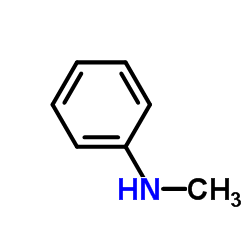N-Methylaniline

N-Methylaniline structure
|
Common Name | N-Methylaniline | ||
|---|---|---|---|---|
| CAS Number | 100-61-8 | Molecular Weight | 107.153 | |
| Density | 1.0±0.1 g/cm3 | Boiling Point | 196.2 °C at 760 mmHg | |
| Molecular Formula | C7H9N | Melting Point | −57 °C(lit.) | |
| MSDS | Chinese USA | Flash Point | 78.9 °C | |
| Symbol |



GHS06, GHS08, GHS09 |
Signal Word | Danger | |
|
Convenient QSAR model for predicting the complexation of structurally diverse compounds with β-cyclodextrins
Bioorg. Med. Chem. 17 , 896-904, (2009) This paper reports a QSAR study for predicting the complexation of a large and heterogeneous variety of substances (233 organic compounds) with beta-cyclodextrins (beta-CDs). Several different theoretical molecular descriptors, calculated solely from the mole... |
|
|
Calculating virtual log P in the alkane/water system (log P(N)(alk)) and its derived parameters deltalog P(N)(oct-alk) and log D(pH)(alk).
J. Med. Chem. 48 , 3269-79, (2005) Growing interest in the use of both the logarithm of the partition coefficient of the neutral species in the alkane/water system (log P(N)(alk)) and the difference between log P(N)(oct) (the logarithm of the partition coefficient of the neutral species in the... |
|
|
Redox inactive metal ion triggered N-dealkylation by an iron catalyst with dioxygen activation: a lesson from lipoxygenases.
Dalton Trans. 44 , 9847-59, (2015) Utilization of dioxygen as the terminal oxidant at ambient temperature is always a challenge in redox chemistry, because it is hard to oxidize a stable redox metal ion like iron(III) to its high oxidation state to initialize the catalytic cycle. Inspired by t... |
|
|
Correlating Infrared and X-ray Absorption Energies for Molecular-Level Insight into Hydrogen Bond Making and Breaking in Solution.
J. Phys. Chem. B 119 , 8115-24, (2015) While ubiquitous, the making and breaking of hydrogen bonds in solution is notoriously difficult to study due to the associated complex changes of nuclear and electronic structures. With the aim to reduce the according uncertainty in correlating experimental ... |
|
|
Synthesis of N-substituted acridinediones and polyhydroquinoline derivatives in refluxing water.
Molecules 17(5) , 5339-45, (2012) Acridinediones were synthesized by the one-pot Hantzsch condensation of an aromatic aldehyde, 5,5-dimethyl-1,3-cyclohexanedione, and aniline/4-methylaniline in refluxing water. This method has then been extended to the four-component reaction of an aromatic al... |
|
|
Synthesis and application of ionic liquid matrices (ILMs) for effective pathogenic bacteria analysis in matrix assisted laser desorption/ionization (MALDI-MS).
Anal. Chim. Acta 767 , 104-11, (2013) Application of two new series of ionic liquid matrices (ILMs) based on the two most predominantly used conventional organic matrices (Sinapinic acid and 2,5-DHB) in conjugation with various bases (aniline (ANI), dimethyl aniline (DMANI), diethylamine (DEA), d... |
|
|
Chemical oxidation of aniline and N-methylaniline: a kinetic study by Raman spectroscopy.
Spectrochim. Acta. A. Mol. Biomol. Spectrosc. 106 , 34-40, (2013) For the first time, chemical oxidation of aniline and N-methylaniline with dichromate as oxidant has been studied by Raman spectroscopy with 785 nm laser beam excitation, and the suitability of this technique for kinetic study of this process was demonstrated... |
|
|
Potassium iodide catalyzed simultaneous C3-formylation and N-aminomethylation of indoles with 4-substituted-N,N-dimethylanilines.
Org. Biomol. Chem. 10(48) , 9519-22, (2012) A one-pot dual functionalization of indoles has been developed. The simultaneous C3-formylation and N-aminomethylation of indoles can be achieved using readily available potassium iodide as a catalyst and tert-butyl peroxybenzoate as a co-oxidant. |
|
|
nBu4NI-catalyzed C3-formylation of indoles with N-methylaniline.
Chem. Commun. (Camb.) 48(42) , 5187-9, (2012) nBu(4)NI-catalyzed C3-selective formylation of N-H and N-substituted indoles by using N-methylaniline as a formylating reagent was first successfully demonstrated.This journal is © The Royal Society of Chemistry 2012 |
|
|
A facile one-pot process for the formation of hindered tertiary amines.
Molecules 17(5) , 5151-63, (2012) A simple and convenient method was developed for the preparation of hindered tertiary amines via direct reductive amination of ketones with secondary aryl amines, using trichlorosilane as reducing agent and tetramethylethylenediamine (TMEDA) as organic Lewis ... |